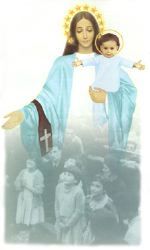People Never Die (Mercedes Salisachs)
People Never Die – An Authoress’s Account
“Your Son is in Heaven”
From The Apparitions of Garabandal, reprinted with kind permission of St. Michael’s Garabandal Center, Maria Saraco
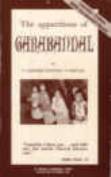
Here is an extract from the book about her visit to Garabandal by the brilliant Catalonian authoress, Mercedes Salisachs.
“Holy Saturday, April 21st, 1962.
I must confess, although I do not consider myself especially gullible where prodigies are concerned, no more do I feel bound to discount them simply on ethical grounds or on established principle.Many have been the ‘gifts’ that God has sent mankind in the course of the centuries. True enough, our faith should not be based on such ‘gifts’, but, if they are genuine, there is nothing to prevent our making use of them to nourish our religious life.
And this was really what I was looking for when I first set out for the village of Garabandal. I wanted to come closer to God and render homage to the Virgin Mary, although, naturally enough, I still had doubts as to the authenticity of the alleged apparitions.
The fact is that my religious life had undergone a considerable change some three and a half years earlier, as a result of the death of my son Miguel, and following an inner crisis that had entirely swept aside the deeprooted habits and theories of a life-time.
Although I was a practicing Catholic, it was from force of habit and a sense of duty rather than from love of God.
My Life, My Son Miguel:
My son, Miguel, on the other hand, was religious in the “spiritual” sense. The firmness of his faith was astonishing; especially the maturity of his reasoning. Without being a mystic, everything he did and thought had an underlying religious purpose, perhaps in contrast with the human effort that any of his ventures entailed.
His artistic work, praised by all the Spanish press following posthumous exhibitions in Madrid and Barcelona, give only a glimpse of the quasi-mystical spirituality which was reflected in his conversation and habits. The final result of his life, however, fully confirmed the greatness of his soul.
He was engaged when he died, and had intended getting married when he was twenty-two. With this in mind, he had done his military service earlier than usual. There was nothing in him to suggest the end he was to meet. Bursting with health, ever making new plans, he was the living embodiment of the future. Yet, on more than one occasion I had heard him exclaim forlornly: ‘I’m wasting my time. The years are catching up with me . . .’ He seemed goaded to these outbursts by something that neither he nor anyone comprehended. Seeing his disquietment, I would do what I could to calm him: ‘But, you’ve got your whole life before you.’ But, his ‘fear’ of not accomplishing what he planned to do was stronger than any reasoning: ‘I haven’t a minute to lose … I must gain time . . .’
All the same, I think his sense of urgency was unconscious. At any rate, I never heard him mention the slightest suspicion of what fate had in store for him. Yet, his maturity was becoming increasingly apparent. The last year of his life was marvelous. The metaphysical evolution he was undergoing was very noticeable. He had succeeded in correcting his own inclination to rebelliousness to such a degree that, if ever it rose to the surface through ill-humor, he at once burst out laughing. ‘There’s nothing so grotesque as a rage’, he used to say. Consequently, his company was a tonic to everybody, and conversation with him was a blessing.
About a month before he died, he and his fiancee decided (I think in fulfillment of a thanksgiving resolution) to receive Holy Communion every day. This new habit, which he never mentioned to me, but which I suspected, accentuated to an even greater degree the signs of his self-control; he had acquired an enviable calm, and his stoicism in adversity was uncommon at his age.
Indeed, adversity crossed his path on not a few occasions. In spite of the apparent ease of his life, year after year, difficulties beset him at every step. It is incredible how many of his ventures were doomed by adversity.
Towards the end, however, he no longer seemed to care about the mounting obstacles that barred his path. He gave the impression that, as far as he was concerned, nothing could really be adverse again. Shortly before his death, he exclaimed to a friend of his: ‘I’ve been to Communion twenty days running. What a fool I am for not having done it before!’ And he slapped his hand to his head in exasperation.
Miguel’s Death:
On October 30th, 1958, after going to Communion as usual, he set off for France with four fellow artists. Ten kilometers from their goal, they had an accident. Two of them were killed instantaneously. Two survived.
Miguel died at six o’clock the following morning, the 31st. I do not think he would have recovered consciousness.
I have given this short account, because the things that happened to me at San Sebastian de Garabandal are closely connected with it.
I have no idea what other mothers can have felt at the loss of a son like Miguel. But, I doubt whether they can have overcome the same sort of emptiness and horror that engulfed me. Our understanding of each other was such that, when speaking of him to me before his death, even his brothers and sisters (to say nothing of his friends) did not bother to mention him by name. They simply said ‘our son’, as though he were the only one.
Everyone considered Miguel as my alter ego, my real confidant and inseparable companion. They were not mistaken.
In our spare time, the three of us (his fiancee, he and I) were wont to get together. We went out together, or else stayed at home, chatting. His whims were always the same as mine and our plans were always made together. For my part, having him at my side was like owning a piece of cosmos. On him I focused all my good aspirations, and I believe he had the same attitude towards me. In faict, he was not just my son, but my best friend, too.
So, it is hardly surprising that his death should have snuffed out the main point in my life, and that, on losing him, I should have felt overwhelmed by the most horrifying, stygian gloom.
People told me that I would get over it in time; that, although I would not manage to forget him, memory of him would gradually fade until he became a pleasant recollection. People said that, little by little, I would get used to not seeing him, not hearing his voice, and that I would eventually accept matters without such a wrench.
But, time went by, and I was still desperate. Although I attempted to hide my sadness, especially so as not to hurt the feelings of my other four children, the more time passed the emptier, sadder and more lost I felt.
Some resorted to religious reasoning. They spoke to me of Christian resignation, reminded me of Miguel’s great faith, of his exemplary death, and said I should praise God for having taken him from me with his soul in such happy circumstances. But, resignation would not come, and all their persuasion struck me as empty, thoughtless arguments.
There even came a time when doubts about my faith became my obsession. Religion took on the appearance of a repair-patch on a burst tire, and everything that I had hitherto admitted without undue effort now started to crumble, plunging me into greater and greater depression. In this fashion, I finally turned into an empty shell with no horizon but the past, and no hope for the future but death.
The collapse of my morale was shattering. The temptation to ‘doubt’ continually assailed me. I got the impression that after death everything was over, that hope was nothing but a great lie, and that faith was a childish myth invented to keep us in order.
My doubts, however, did not win completely. Sometimes, for some unknown reason, hope returned. ‘What if Miguel can see me? What if the dogma of the Communion of Saints is true . . . ?’ It was as if Miguel were tugging at me; as if he were screaming out to me to arouse me from my apathy.
At that period, I could not even pray. I always ran into a blank wall of doubt. On one occasion, I remember, my mother suggested we should all say the rosary together, and (I still feel ashamed at my retort) I refused because I considered it ‘vulgar’.
Proof:
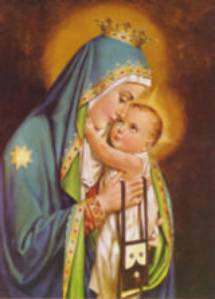
The fact was, I needed some proof; something to make me realize that, beyond death’s threshold, life continued. But proof was not forthcoming, and, to tell the truth, I did not do anything to seek it out either. My devotion to Our Blessed Lady was practically non-existent.
One day, shortly before the feast of the Immaculate Conception, almost instinctively I found myself before a statue of Our Lady of Sorrows, begging the Blessed Virgin to give me proof that Miguel indeed existed still.
Proof was not long in coming. It was indisputable evidence. So incontestable was it that, even if someone were now to explain it away with normal arguments, I should still be convinced that what happened was nevertheless an answer from Our Lady.
From that day onwards, I had no other obsession than to return to God. Five months later (on May 4th, 1959, to be exact), I made a general confession and my peace with God, once and for all, resolving never to part from Him for a single second of my remaining life.
From that moment, everything began to change for me. Though I still missed Miguel greatly, and loneliness continued to torment me, my inward peace was now a great balm.
Reciting the rosary ceased to strike me as ‘vulgar’, and my devotion to the Virgin Mary grew day by day.
So it was that, when I heard of the children of Garabandal, I made up my mind to visit their little village, not just out of curiosity, but with the idea of rendering homage to the Virgin, even though the authenticity of the phenomena might be debatable.
My First Trip
Taking advantage of the fact that the family was away in Switzerland at the time, I left Barcelona on Maundy Thursday (1962), accompanied by our chauffeur, Jose, and his wife, Mercedes. We reached Cosio at noon on Good Friday.
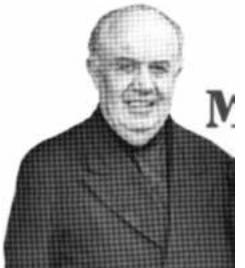
In Cosio, I met the parish priest of Garabandal, Don Valentin Marichalar. While waiting for the car that was to drive us up to the village, I had an opportunity of speaking to him. He struck me as a kindly man, intelligent yet simple. As far as I could make out, his position was a very awkward one. Obedience to his superiors obliged him to be stern about the prodigies, and this severity was not always taken with good grace by his parishioners.
Despite his caution, he ended up by confessing that, at heart, he was convinced that the phenomenon occurring there was supernatural, and that their innocence made the little girls worthy to receive the visits of the Virgin.
He also spoke to me of the outstanding moral uprightness of the villagers, their religious fervor and a long-standing custom of saying the rosary in the village church every evening, even when he himself was away.
This chat with the village priest heightened my curiosity to meet the children. It was 2 p.m. when the car that was to take us turned up. Fidel, the driver, informed us that Fr. Corta, a Jesuit who had come to help Fr. Marichalar with the Holy Week ceremonies, was then about to give Holy Communion. The village en masse had congregated in the church.
From time to time, the children passed close to us. They appeared to be on very friendly terms with the Santa Marias, through whom I managed to get introduced to the private circle of each one.
That afternoon, I entrusted Jacinta with some pious objects to give to the Virgin to kiss. I made her and her fellow visionaries the same request: ‘Ask the Virgin for news of my son.’ I think it was Jacinta who inquired: ‘What’s wrong with your son?’ I told her he had died.
This done, I made my way to Mary Loli’s, where everyone was waiting for her next apparition. I gave Mary Loli a sheet of paper written on both sides. On handing it to her, I told her that I did not expect an answer. ‘The only thing I should like to know is where my son is.’ I did not mention his name. The one who might have known it was Jacinta, since I had left a commemoration card of his on the table for the Virgin to kiss. Jacinta might quite feasibly have informed Mary Loli secretly, but it does not seem in keeping for Mary Loli to lie when she told me that the name ‘Miguel’ was given her by the Virgin.

I still did not know how the visions occurred. Though they had been explained to me, I found it difficult to visualize them. I have now been to Garabandal three times and have seen many ecstasies, yet I still think there is no way of describing, not just the visionaries’ “fall”, their facial expressions and movements, but the atmosphere of respect that always reigns supreme when ‘the apparitions arrive’, in spite of the background of some of the tourists and the villagers’ familiarity with these events.
A few days ago, I asked the children whether they had got accustomed to the idea of seeing the Blessed Virgin. Mary Loli came out with a very subtle reply. ‘At this minute, I feel as if I have got accustomed now; but, when I see her again, it’s as if it was something new.’
Well, that is in fact precisely the case with those of us who are present during an ecstasy. We feel as if we were already used to them; but, on seeing them afresh, we are still overcome with surprise.
At first sight, nothing that the children do appears to have any point to it. Their movements, their swaying motions, their headlong running, their conversations in an undertone, their insistence when proffering the crucifix in their hands for people to kiss . . . All these factors at first leave the onlooker open-mouthed in wonder at their incongruence and apparent inconsistence. (There is a priest who stated in his report that the goings-on at Garabandal were ‘hardly dignified’, most likely overlooking the scant dignity at Lourdes). Even admitting the undignified appearance of events, nothing that occurs there occurs without a purpose. The trouble is that, to grasp this, you have to stay in the village at least three days. Once you are acquainted with the apparent incongruence, everything is clear. Whether instantaneously or belatedly, the explanation is always forthcoming.
I, for my part, ought to add that, although my yearning was great, my hope was weak. I had approached my trip the same way one does a pilgrimage. I was prepared to put up with any discomforts or obstacles.
It was not long before we heard the characteristic thud of Mary Loli falling to her knees. It came from upstairs. Silence fell and only a short time had elapsed when we saw Mary Loli descending the stairs, her eyes staring heavenwards and her face transfigured, holding hands with another little girl.
I do not think the greatest actress could imitate that expression.
Mary Loli went to the table on which lay the objects to be presented to the Virgin. She began to hold them aloft to be kissed. I saw her pick up my sheet of paper, raise it on high, turn it round and deposit it on the table once more.
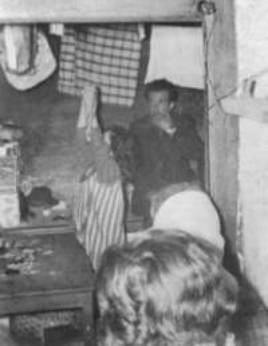
Then, clutching her crucifix, she went out into the street.Her regular strides were light and easy. It was as though she were walking on a smooth, flat surface. She was unaware of the quagmires, puddles, rubble and stones underfoot …
Somehow or other, I grabbed the arm of the child to whom she was clinging, but, after a halt at the church door, Mary Loli started up the mountainside and I was forced to relinquish my hold. Exhaustion prevented my following them any farther. I felt as though my galloping heart beats would give out at any moment, so steep was the slope leading up to the pine grove.
Thus far, the evening had been none too pleasant as far as I was concerned. Often though the child had given the Cross to be kissed, she had overlooked me. I was deeply pained by the suspicion that, if all this was true, the Virgin Mary was deliberately evading my kiss.
When Mary Loli at last started down the mountainside, I saw her running backwards, her gaze piercing the gloom overhead, avoiding obstacles and pot holes as if she had eyes in the back of her head. When she reached the village, she was joined by Jacinta; they laughed as they met. . . Both of them proffered their crucifixes for people to kiss and walked on arm in arm.
At the church door, Jacinta emerged from her trance. Mary Loli returned home, still in a state of ecstasy.
I called Jacinta to me and asked for news of Miguel. The child replied that the Virgin had not answered her query. Downcast, I tackled Mary Loli next. Her response was identical. “Did she read my sheet of paper?” I urged. “Yes, she read it.”
Disappointment:
Realizing my disappointment, Fr. Corta inquired when she would see Our Lady again. “From two o’clock to half past two,” she said. Fr. Corta suggested that she should once more ask the Virgin for news of my son when she saw her again.
That same night, when Mary Loli fell into an ecstatic trance for the second time, she was joined at once by Jacinta who was walking around the streets in a trance, too. Again, they gave all the onlookers their crucifixes to kiss; again, when they came my way, they passed my lips by.
But the worst of all was what they told me on re-emerging. Both Jacinta and Mary Loli told me the same story. “The Blessed Virgin gave me her answer, but I can’t tell you what it is.”
That reply was far worse than the previous one. There was no escaping the obvious conclusions. Either I did not deserve to be answered by the Virgin, or else, despite every supposition to the contrary, Miguel was in a place of which it was “better to remain in ignorance”.
I goaded Mary Loli to tell me whether the Virgin’s answer was pleasant or otherwise. “I can’t say, I can’t say . . .” she evaded my questioning. Her face was quite inscrutable.
Fr. Corta again tried to come to my rescue. He saw I was upset, and doubtless felt sorry for me. “Can you tell her tomorrow?” The child shrugged. “Perhaps …”
Going to bed that night, 1 felt as if I had been turned into a block of ice. The suspicion that neither God nor Our Blessed Mother wanted to have anything to do with me depressed me as much as my assumption that Miguel might be suffering punishment. But, somehow it seemed out of the question to doubt Miguel’s salvation.
I wondered whether my conscience was, perhaps, not as clear as it might be. Yet, much as I tried to probe it and discover some grievous sin, I could recall nothing. I told myself that maybe the Virgin wanted me to show greater piety, more care when reciting the rosary, more humility . . .
One-by one, I re-examined the phenomena that I had witnessed throughout that day and night. I desired with all my heart to discover a “flaw”, grounds to disprove their authenticity . . . something that would make me see clearly that what was happening in Garabandal was sheer mumbo-jumbo. But, the more I went over the facts in my mind, the more authentic everything seemed. The only flaw in the whole set-up was myself. That was undoubtedly why the Virgin did not want me to kiss the crucifix.
Holy Saturday was a barren day, too. Notwithstanding the kindness shown me by the Santa Marias, Fr. Corta, Fr. Marichalar, the sergeant-major of the Civil Guard and even the mothers of the visionaries, everything in the village seemed hostile to me. Their kindness was no doubt due to the pity and distrust awakened in them by the isolation to which the Virgin had sentenced me. To me, it was of no importance at all what people might be thinking. What hurt me most was that continual disdain.
It was then that I first began to have a presentiment that everything that was happening to me was sheer trickery, a sort of trap … I remembered that it was Holy Week. Could all this have something to do with the liturgy? I hardly dared think so; it seemed too subtle, too easy a way out. . .
But, the fact is, with the coming of that presentiment, I lost all notion of fear. I accepted everything and submitted to God’s will.
That night, I had supper alone in the tavern. Afterwards, the sergeant-major of the Civil Guard took me round to Conchita’s house.
Conchita’s mother welcomed me kindly and offered me a seat next to her daughter. The heat of the fire on the hearth was bothersome, and I began to feel increasingly uncomfortable. But, as the hours passed, my morale gradually revived.
We chatted of this and that, of things that were not particularly closely connected with the visions. The most striking thing about those children is their naturalness in everyday life. They accept the supernatural with almost incredible simplicity. They feel that anyone can “see the Virgin”, and that what is happening to them is perfectly normal.
What really worries them is to see people’s disbelief. Over and over again, they ask people, “Do you believe? Do you really believe I see the Virgin?” They probably think that it depends on that belief whether or not the Virgin works the great miracle that she lias been announcing from the very first. Conchita is particularly prone to this worry. When least expected, there she is asking, “Do you believe?”
Apart from this, they are always very sure of themselves when it comes to theological matters. Notwithstanding their obvious innocence, the perspicacity in their remarks is astounding.
Second Trip:
(On my second trip, when Conchita gave me in writing the messages that the Virgin had given her for me, I was overcome by what I was reading, and told her I did not deserve such generosity because I was not good enough and did not make sufficient sacrifices, and Conchita answered with a firmness that is uncommon in an ignorant, uneducated child. “It’s enough to do our duty; Our Lady asks no more!”)
That night, Conchita gave free reign to her tongue. Between them, she and Aniceta, her mother, recounted with a great sense of humor all the past events: the vision of St. Michael the Archangel; the colloquies they had had with the late Fr. Andreu; Conchita’s trip to Santander and the story of her visit to the hairdresser’s, where they cut off her plaits. Bit by bit, the house began to fill up. The blazing kitchen fire was too much for me and the air was becoming unbearable.
I was out of the room when Conchita fell to her knees in an ecstasy, and unable to see exactly what occurred.
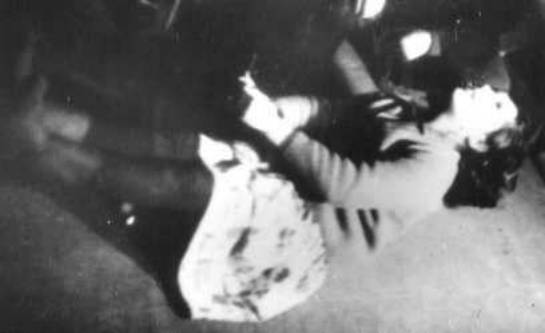
After kneeling down, she arched over backwards until she was reclining on the floor. All at once, it was as if she was lifted upwards. People round her claimed that not a single part of her was touching the floor, but I cannot testify to this case of levitation because, from where I stood, I could not be certain. When she went out, however, I was able to see what happened to a newcomer to Garabandal, Senor Mandoli.
Although a practicing Catholic, he did not believe in visions. I suddenly saw Conchita turn in mid-stride and come straight towards us (Senor Mandoli was beside me) to offer him the crucifix. But, either out of shyness, or perhaps to put her to the test, he evaded her. Her head flung back, never once looking to see where she was stepping, Conchita pursued him relentlessly until she managed to get him to kiss the crucifix.
Much moved, Senor Mandoli confessed to me that he had just asked the Blessed Virgin, if all this business was true, to make Conchita seek him out and give him her crucifix to kiss.
If my memory serves me right, I was not given the crucifix to kiss that night either. If I did manage to kiss it at any particular point, it was purely by chance in passing as it was offered to someone else.
Walking on, Conchita joined the other three children, who were likewise in a trance. Light of step as usual, they linked arms as they proceeded up the street followed by the crowd.
I recalled that the other apparitions (Lourdes and Fatima) had been local and ecstatic, and it struck me that the ones I was witnessing could perhaps be explained by the ways of our modern times. It was as though the Virgin Mary, like Pope John XXIII, wished to adapt her mercy to the restless seeking of those in need of it.
When you come to think of it, it would look somewhat out of place in these days to see ecstatic trances of the same ilk as those at Fatima and Lourdes. People need another kind of tonic, other methods, another approach. And the methods in the case of these children were perfectly suited to our needs. The apparitions had become “approachable”; everybody could take part in them at a distance; anybody who wished could participate indirectly in the conversations between the visionaries and the apparition. According to the children, from the very first, the Blessed Virgin showed every sign of “desiring to close the gap” between herself and the onlookers. She allowed them to ask her questions; she suggested they give her pebbles to kiss. All together, the impression was that she wanted to break down all barriers.
At that moment, however, I was so depressed by the apparent “disdain” that the Apparition was showing me that, without stopping to think of the undoubted generosity she was showing the others, I firmly resolved not to ask any more questions or to expect the slightest sign through the children.
Following a long-standing local custom, in the early hours of Easter Sunday, the village women started to sing the rosary. Despite my weariness, I felt impelled to join them. The devoutness of that scene was truly impressive; I cannot remember ever having spent an Easter of such profound religious fervor as that one.
As we advanced, the night sky cleared. The rooftops shone almost as brightly as the moon and stars.
We must have been mid-way through the third mystery when the unexpected happened.
My Answer:
All at once, I felt someone prodding me in the back. Turning, I saw the Marquesa de Santa Maria arm in arm with Mary Loli. “Mary Loli says she has something to say to you,” she confided.
At that moment, I could not think what she was referring to. I remembered that, following her ecstasy that evening (before midnight Mass, of course), I had spoken to the child and she had been as secretive as ever. Just as I had resolved, I had asked her no further questions, and she, for her part, had shown no signs of wishing to talk either. So, I could not grasp what she could possibly want to tell me.
But Rosario Santa Maria added: “It’s something to do with what the Virgin told her yesterday, but it seems she was commanded to keep it quiet until after one o’clock today . . .”
Rather abashed, Mary Loli was saying: “Later on; I’ll tell her afterwards . . .” We were walking along in procession reciting the rosary, and it was hardly proper to halt for a mere message.
Confused, I did not know whose side to take. But Rosario, who had seen the time I had been having, insisted: “Not on your life; you’re to tell her this minute. You can’t leave this poor lady with such a worry on her mind.”
Mary Loli and I drew slightly away from the procession. Disconcerted, and still fearful of what might be in store for me, I bent down for the little girl to whisper in my ear.
In a clear voice she gave me the message. “Our Lady says your son is in Heaven.”
I cannot say precisely what happened after that. Everything about me seemed in such a whirl that it is no easy matter to reconstruct the scene. Everything, absolutely everything, was as nought beside that one sentence.
The only thing I remember clearly was hugging Mary Loli as if I were embracing Miguel. Then, I found myself hugging Rosario. She, too, was crying. She was saying so many things at the same time that I could not hear her. People were milling round about us; it was like being on a roller-coaster with more and more people joining us as we spun round. I could see Fr. Marichalar, Fr. Corta, Eduardo Santa Maria, the sergeantmajor of the Civil Guard . . . They were all looking at me, fright mingling with emotion in their faces. Alarmed at this interruption, Conchita’s mother came over to comfort me. “If she’s crying because they haven’t given her the crucifix to kiss, tell the lady that they haven’t given it to me tonight, either.”
They told her mine were tears of joy; the good woman looked relieved. The rest of that rosary was like winging up to Heaven. All my earlier depression had disappeared; I recollect handing Rosario Santa Maria my walking-stick and clinging to Mary Loli’s arm. Never in my life had I felt so light-hearted or so secure. Tears still stinging my eyes, we rejoined the procession through the streets in those early hours before dawn. I think I prayed more with my eyes than with my lips. Mary Loli was saying over and over: “Don’t cry, don’t cry . . .” But, there was no taking any notice of her plea. There was so much to cry about! She insisted: “You ought to be very happy.”
Now, I did not bother to look where I was going. I no longer needed a torch; Mary Loli’s arm was firm in mine. Full of confidence in her guidance and trust in the Blessed Virgin, I walked the rest of the way gazing up at the heavens. I have never seen the sky so clear and studded with stars; every twinkle was a smile.
It was 3 a.m. when we reached the tavern. Mary Loli’s visions had been announced for 4:30 a.m. Still stunned by what had happened to me, I saw Rosario whispering to Mary Loli. “But, my dear child,” she exclaimed, “don’t keep it to yourself . . .! Tell her now.” Coming over to me, Rosario added: “Mary Loli says the message she gave you is incomplete, but as you started to cry she couldn’t go on telling you the rest of it.”
What the child had to tell me this time left me still more overcome. “She also told me that your son is very happy, extremely happy, and he’s at your side ‘every day’.“
She at once went on to confirm what Rosario had already intimated. “I already knew your son was in Heaven; Our Lady told me so yesterday. But she also said, “Don’t tell the lady until tomorrow, after Sunday Mass,’ That’s why I kept quiet about it until now.“
Such subtlety could not be the work of a child. Moved, I enjoined Mary Loli time and again to tell the Virgin, when next she saw her, to ask anything she wished of me, for, whatever it was, I would gladly give it to her. Afterwards, however, whenever I inquired whether she had conveyed my request to the Virgin, she replied that she had “forgotten.” I told myself, by this “forgetfulness,” she wished to give me to understand that when the Virgin gave something, she gave it unconditionally.
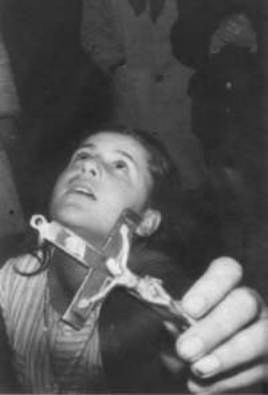
From the moment of that crisis, everything changed for me. No sooner had the child fallen to her knees in a trance that I had proof that my earlier “ostracism” had ended. She came straight to me. She held the crucifix to my lips once, twice, thrice . . .; then, making the Sign” of the Cross over my forehead, lips and heart, she held the crucifix up for the Virgin to kiss once more and, as if in final confirmation of all she had just told me, she held it out to me again.
Thereupon, without proffering it to anyone else, she went out into the night.
Outside, Mary Loli’s father, Ceferino, beckoned us over. “She’s talking to the Virgin about you,” he said. Sure enough, she was undoubtedly speaking about me. “I told her not to cry, and that she ought to be happy, but she took no notice . . .” After a brief pause, she asked: “And what if she starts crying again when I tell her?”
From that night onwards, they never failed to proffer me the crucifix.
As soon as she emerged from her trance, Mary Loli came over and informed me in a low voice that Our Lady had given her another message. She waited until we were alone. “While I was speaking to the Virgin,” she began, “I noticed she was laughing a lot and looking upwards; and, when I asked her why she was laughing so, she replied that, at the very moment she was talking to me, ‘he’ was looking at you and was very happy …”
“Who do you mean, Mary Loli? M ….. .?” I could not get his name out.
But she forestalled me. “That’s right, Miguel. She said to me: ‘Above all, tell the lady that this very minute while I am speaking to you, Miguel is watching her, and that he is full of joy, that he is very happy; very, very happy . . . indeed.“
“Tell me, Mary Loli. How do you know his name is Miguel?”
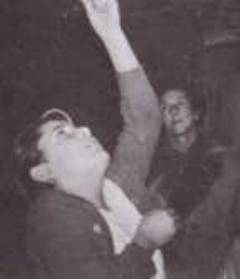
PICTURE: “She held the crucifix up for the Virgin to kiss. . .”
The little girl was quite unperturbed. Very simply, she replied: “Because I asked her: ‘Who is Miguel?’ And she said to me: ‘That lady’s son’.”
I have confirmation of all this recorded on tape. The following day, I begged Mary Loli to record that passage so my husband could hear it. Naturally, the flow of our conversation was less spontaneous than the previous night, but the general lines and atmosphere of it were the same. The little girl seemed bashful about speaking into a microphone. Nevertheless, on my second trip, when she recounted what had happened for my daughter’s benefit, in spite of the time that had elapsed, she told the whole story without omitting the minutest detail.
Unfortunately, when he heard the tape, my husband seemed not to be convinced. He had to go to Garabandal before he would admit that what Mary Loli claimed might be true.
Conchita was the last to have an ecstasy that night. It lasted almost two hours. Dawn had already broken when she came to. She was surprised; she fondly imagined only a “short moment” had passed.
I returned to the house where I was lodging, as if I was walking on air. The village was tinged with blue under a sky in which the stars still shone. The first rays of the rising sun were peeping over the mountains.
Reprinted with kind permission from The Apparitions of Garabandal
Maria Saraco and the St. Michael’s Garabandal Center.
To see complete “Apparitions ..” book click here. or to order.
Back for more Garabandal Information

